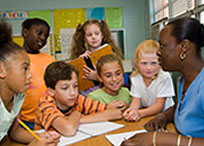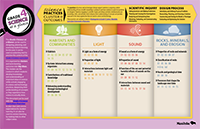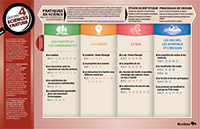
GRADE 4: SCIENCE
What your child is learning
In Grade 4, children learn about how plants and animals interact in their environment and how humans can have an effect on populations of plants and animals. Grade 4 children investigate properties of light and recognize that it travels in a straight line. Another form of energy, sound is also explored. They learn about how sound is produced, how it travels and how the human ear is designed to hear sounds. Children also explore the characteristics and properties of rocks and minerals, and how these properties help determine their use by people.
To find out more about what your child is learning, we encourage you to talk to the teacher. You may also find helpful information on the Curriculum Essentials posters, which are interactive PDFs designed for teachers that provide an overview of the knowledge, processes, and skills for this subject area.
The first page gives an overview of what your child will be learning, grouped into big ideas so that the curriculum is easier to understand. The number codes correspond to the curriculum learning outcomes. The arrow at the top of the page highlights the skills and attitudes, which are described in more detail on the third page. These should be integrated throughout the teaching and learning of science. The second page offers a more detailed description about the expectations related to the big ideas and the categories found on the provincial report cards regarding assessment.
You may also wish to refer to the Grades K-4 Science - Manitoba Curriculum Framework of Outcomes.
How your child is assessed
The teacher will assess your child’s progress in the areas described in the WHAT MY CHILD IS LEARNING tab. The teacher will also assess how your child uses scientific inquiry, solves problems and makes decisions in science. The reports you receive from the school help you to support your child’s learning. You can use them to talk with your child and your child’s teacher about results, strengths, challenges and what your child will be doing next.
Resources
Children are naturally curious and are eager to explore and discover the world that surrounds them. Cultivate this curiosity. Consider games and toys that nurture the design process and problem solving.
Here’s a few website you can start with to get some ideas.
Try Science – science activities for children and their families that can be done at home.
Let’s talk science offers a comprehensive database of science activities for the families.



 536 KB)
536 KB)
